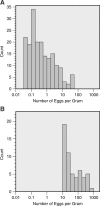Study of diagnostic accuracy of Helmintex, Kato-Katz, and POC-CCA methods for diagnosing intestinal schistosomiasis in Candeal, a low intensity transmission area in northeastern Brazil
- PMID: 29518081
- PMCID: PMC5843168
- DOI: 10.1371/journal.pntd.0006274
Study of diagnostic accuracy of Helmintex, Kato-Katz, and POC-CCA methods for diagnosing intestinal schistosomiasis in Candeal, a low intensity transmission area in northeastern Brazil
Abstract
Control initiatives have successfully reduced the prevalence and intensity of schistosomiasis transmission in several localities around the world. However, individuals that release low numbers of eggs in their feces may not be detected by classical methods that are limited by low sensitivity. Given that accurate estimates of prevalence are key to implementing planning control actions for the elimination of schistosomiasis, new diagnostic tools are needed to effectively monitor infections and confirm transmission interruption. The World Health Organization recommends the Kato-Katz (KK) thick smear as a parasitological test for epidemiological surveys, even though this method has been demonstrated to underestimate prevalence when egg burdens are low. The point-of-care immunodiagnostic for detecting schistosome cathodic circulating antigen (POC-CCA) method has been proposed as a more sensitive substitute for KK in prevalence estimations. An alternative diagnostic, the Helmintex (HTX) method, isolates eggs from fecal samples with the use of paramagnetic particles in a magnetic field. Here, a population-based study involving 461 individuals from Candeal, Sergipe State, Brazil, was conducted to evaluate these three methods comparatively by latent class analysis (LCA). The prevalence of schistosomiasis mansoni was determined to be 71% with POC-CCA, 40.% with HTX and 11% with KK. Most of the egg burdens of the individuals tested (70%) were < 1 epg, thereby revealing a dissociation between prevalence and intensity in this locality. Therefore, the present results confirm that the HTX method is a highly sensitive egg detection procedure and support its use as a reference method for diagnosing intestinal schistosomiasis and for comparative evaluation of other tests.
Conflict of interest statement
I have read the journal's policy and the authors of this manuscript have the following competing interests: C.Graeff-Teixeira has a patent deposited in Brazil for the method Helmintex.
Figures



Similar articles
-
Evaluation of diagnostic methods for the detection of intestinal schistosomiasis in endemic areas with low parasite loads: Saline gradient, Helmintex, Kato-Katz and rapid urine test.PLoS Negl Trop Dis. 2018 Feb 22;12(2):e0006232. doi: 10.1371/journal.pntd.0006232. eCollection 2018 Feb. PLoS Negl Trop Dis. 2018. PMID: 29470516 Free PMC article.
-
Concordance of the point-of-care circulating cathodic antigen test for the diagnosis of intestinal schistosomiasis in a low endemicity area.Infect Dis Poverty. 2019 May 30;8(1):37. doi: 10.1186/s40249-019-0551-7. Infect Dis Poverty. 2019. PMID: 31142379 Free PMC article.
-
Diagnostic comparison of stool exam and point-of-care circulating cathodic antigen (POC-CCA) test for schistosomiasis mansoni diagnosis in a high endemicity area in northeastern Brazil.Parasitology. 2021 Apr;148(4):420-426. doi: 10.1017/S0031182020002164. Epub 2020 Nov 16. Parasitology. 2021. PMID: 33190646 Free PMC article.
-
Evaluation, Validation, and Recognition of the Point-of-Care Circulating Cathodic Antigen, Urine-Based Assay for Mapping Schistosoma mansoni Infections.Am J Trop Med Hyg. 2020 Jul;103(1_Suppl):42-49. doi: 10.4269/ajtmh.19-0788. Am J Trop Med Hyg. 2020. PMID: 32400347 Free PMC article.
-
Comparison of Schistosoma mansoni Prevalence and Intensity of Infection, as Determined by the Circulating Cathodic Antigen Urine Assay or by the Kato-Katz Fecal Assay: A Systematic Review.Am J Trop Med Hyg. 2016 Mar;94(3):605-610. doi: 10.4269/ajtmh.15-0725. Epub 2016 Jan 11. Am J Trop Med Hyg. 2016. PMID: 26755565 Free PMC article.
Cited by
-
Reliability of point-of-care circulating cathodic antigen assay for diagnosing schistosomiasis mansoni in urine samples from an endemic area of Brazil after one year of storage at -20 degrees Celsius.Rev Soc Bras Med Trop. 2022 Feb 25;55:e0389. doi: 10.1590/0037-8682-0389-2021. eCollection 2022. Rev Soc Bras Med Trop. 2022. PMID: 35239906 Free PMC article.
-
Evaluation of a modified quantitative polymerase chain reaction assay for genus Schistosoma detection using stool and urine samples from schistosomiasis endemic areas in Kenya.PLoS One. 2024 Sep 20;19(9):e0310118. doi: 10.1371/journal.pone.0310118. eCollection 2024. PLoS One. 2024. PMID: 39302938 Free PMC article.
-
Accuracy of the urine point-of-care circulating cathodic antigen assay for diagnosing Schistosomiasis mansoni infection in Brazil: A multicenter study.Rev Soc Bras Med Trop. 2023 Jan 23;56:e0238-2022. doi: 10.1590/0037-8682-0238-2022. eCollection 2023. Rev Soc Bras Med Trop. 2023. PMID: 36700600 Free PMC article.
-
Tools for Detection of Schistosomiasis in Resource Limited Settings.Med Sci (Basel). 2018 May 23;6(2):39. doi: 10.3390/medsci6020039. Med Sci (Basel). 2018. PMID: 29789498 Free PMC article. Review.
-
Evaluation of the Urine POC-CCA Test Accuracy in the Detection of Schistosoma mansoni Infection: A Systematic Review and Meta-Analysis.J Trop Med. 2024 Jul 15;2024:5531687. doi: 10.1155/2024/5531687. eCollection 2024. J Trop Med. 2024. PMID: 39040853 Free PMC article. Review.
References
-
- WHO. Schistosomiasis: number of people treated worldwide in 2014. Wkly Epidemiol. 2016;91:53–60. Available from: http://apps.who.int/iris/handle/10665/254287. - PubMed
-
- Zoni AC, Catalá L, Ault SK. Schistosomiasis Prevalence and Intensity of Infection in Latin America and the Caribbean Countries, 1942–2014: A Systematic Review in the Context of a Regional Elimination Goal. PLoS Negl Trop Dis. 2016;10(3):e0004493 doi: 10.1371/journal.pntd.0004493 - DOI - PMC - PubMed
-
- WHO. Schistosomiasis Progress Report 2001–2011 and Strategic Plan 2012–2020. 2013. Available from: http://apps.who.int/iris/handle/10665/78074.
-
- Haggag AA, Rabiee A, Elaziz KMA, Hay RA, Ramzy RMR. Mapping of Schistosoma mansoni in the Nile Delta, Egypt: Assessment of the prevalence by the circulating cathodic antigen urine assay. Acta Tropica. 2017;(167):9–17. - PubMed
-
- Kittur N, Castleman JD, Campbell CH Jr., King CH, Colley DG. Comparison of Schistosoma mansoni prevalence and intensity of infection, as determined by the Circulating Cathodic Antigen Urine Assay or by the Kato-Katz Fecal Assay: A Systematic Review. Am J Trop Med Hyg. 2016;94(3):605–610. doi: 10.4269/ajtmh.15-0725 - DOI - PMC - PubMed
Publication types
MeSH terms
Substances
LinkOut - more resources
Full Text Sources
Other Literature Sources
Research Materials

